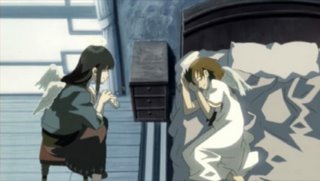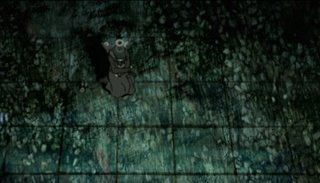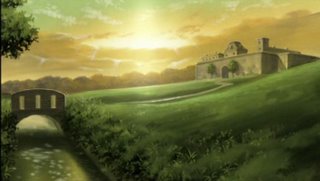Inspiration Part One: Haibane Renmei
Note: Okay, first off, my apologies for being so late with this. I said Wednesday would be the day I did this, and now it's Friday (technically) and I finally have posted this. Well, it's going to be a multi-part post, first of all. I'm going to first do this piece on Haibane Renmei, then follow it up with Wolf's Rain, and hopefully finish up with one of my favorite anime films: Jin-Roh: The Wolf Brigade. I hope you enjoy this little series of posts.
Definitive links between literature and anime are hard to find, if for the simple reason that most Americans haven't read enough Japanese literature to catch them. It's like a foreigner trying to catch all the movie references in Scary Movie (any of them, and yes this is a poor comparison to what I'm about to dive into) - for the average person it's just not possible. There are a few cases that should be more apparent than most, and one of those is Haibane Renmei. It's an interesting case - Yoshitoshi Abe crafted a beautiful, one might say almost ingenious, world with a level of mysticism and depth matched only by the intensive beauty of his characters. You'd never guess that the world, at the very least, is for the most part ripped in its entirety from a printed work: that of Harkuki Murakami's Hard-boiled Wonderland and the End of the World.
 To summarize the anime: Haibane Renmei follows the beginning of the life of a young haibane named Rakka, who enters the world in a cocoon and seeks to find her purpose in a mysterious world with a very interesting set of rules. When she wakes, or is born (depending on how you view it), she finds herself in a town surrounded by a towering wall, with two distinct classes - humans and haibane. The humans live out their lives in the town, while the haibane ready themselves for their "day of flight" - an enigmatic event that no one quite understands. All that is known is that on the "day of flight" a haibane leaves the town forever. There are many locales within the town: a library, where many ancient artifacts can be found, a mechanic's shop (for clocks, mainly), a bakery, etc. There is also the dangerous forest, which the haibane avoid for religious/superstitious reasons. Haibane Renmei is, like most anime, character-driven. Rakka and her relationships with the other haibane drive the story and serve to show a progression, how she matures and her character changes over the course of her stay in this new world.
To summarize the anime: Haibane Renmei follows the beginning of the life of a young haibane named Rakka, who enters the world in a cocoon and seeks to find her purpose in a mysterious world with a very interesting set of rules. When she wakes, or is born (depending on how you view it), she finds herself in a town surrounded by a towering wall, with two distinct classes - humans and haibane. The humans live out their lives in the town, while the haibane ready themselves for their "day of flight" - an enigmatic event that no one quite understands. All that is known is that on the "day of flight" a haibane leaves the town forever. There are many locales within the town: a library, where many ancient artifacts can be found, a mechanic's shop (for clocks, mainly), a bakery, etc. There is also the dangerous forest, which the haibane avoid for religious/superstitious reasons. Haibane Renmei is, like most anime, character-driven. Rakka and her relationships with the other haibane drive the story and serve to show a progression, how she matures and her character changes over the course of her stay in this new world.Hard-boiled Wonderland and the End of the World (hereafter referred to as: HWEW) on the other hand is two separate stories. One (the hard-boiled wonderland one) centers around a man who works as a living encode/decode device. He finds himself embroiled in a far-fetched plot in a techno-futuristic version of Tokyo that is not all that it appears. The other (the end of the world one) deals with a man (perhaps the same one...) trapped in a town with a huge wall around it, a library, where many ancient artifacts can be found, a dark forest that everyone in the town avoids for some very interesting reasons, etc.
I think after those two summaries the general similarities should be glaringly
 obvious. Abe's work borrows the entire "town" concept from Murakami, though with some very distinct differences. First though I'll go a little deeper into the similarities - the wall, for one, is huge. In both, it's impossible to surpass, and dangerous to try to circumvent. It serves as an obvious symbol of containment, and to some extent constraint. And, well, this is where the similarities end, for the most part. You see, Abe and Murakami took very different paths to tell their stories.
obvious. Abe's work borrows the entire "town" concept from Murakami, though with some very distinct differences. First though I'll go a little deeper into the similarities - the wall, for one, is huge. In both, it's impossible to surpass, and dangerous to try to circumvent. It serves as an obvious symbol of containment, and to some extent constraint. And, well, this is where the similarities end, for the most part. You see, Abe and Murakami took very different paths to tell their stories.For Abe, his story was about new beginnings and redemption. There are two principal characters in his story, in a way mirroring Murakami's work, Rakka and Reki. The first character embodies the "new beginning," and carries Abe's concept of maturity. Rakka's sense of wonderment at her surroundings, and especially her handling of Kuu's departure serve to demonstrate this. We watch her grow over the course of the series, at first unable to support herself, until finally at the end she is the one who supports the others. The second character embodies "redemption." Reki spends her whole life in the town trying to atone for her sins, sins she does not even realize herself. It is not until the end of the series that we discover why she has been punished, and how she can escape.
For Murakami, his story was about identity and the significance of the subconscious. What defines us as beings, how do we cope with that reality, and how does our subconscious (our "me") affect us and our decisions. I have not read this book enough times to comment thoroughly on this issue, but let's just say that his work is powerful and creates a sense of the identity crisis that Japan is experiencing today. It asks some of the universal questions: "why am I here?" and "what is my purpose?" while letting the reader decide the answers for him or herself.
 How do the two link together other than through the surface construct of the town? Mainly, it lies in the idea of the subconscious. In HWEW, there is only one "haibane" per se - the main character. He is alone in the town, the only being that does not belong. In Haibane Renmei, there are numerous haibane, and their interactions dictate how they act. This is a central difference, as well as a tie between the two. While HWEW concentrates on how the individual acts, Haibane Renmei serves to dissect how our relations with others form us and influence our decisions as people. The main character in HWEW acts alone, the haibane act together.
How do the two link together other than through the surface construct of the town? Mainly, it lies in the idea of the subconscious. In HWEW, there is only one "haibane" per se - the main character. He is alone in the town, the only being that does not belong. In Haibane Renmei, there are numerous haibane, and their interactions dictate how they act. This is a central difference, as well as a tie between the two. While HWEW concentrates on how the individual acts, Haibane Renmei serves to dissect how our relations with others form us and influence our decisions as people. The main character in HWEW acts alone, the haibane act together. There is also the nature of the town itself. While in HWEW, we can surmise that the town is the main character's subconscious, in Haibane Renmei, the distinction is not so clear. There are many theories - perhaps the town is a type of purgatory, a place for people who have yet to become full and complete beings repent for their sins or reach a higher state of enlightenment, perhaps the town is a place for beings about to be sent to earth to interact and come to realize the sorts of trials they will experience on earth. Regardless, it is a place of interaction between numerous individuals, not the isolated tomb in HWEW.
There is also the nature of the town itself. While in HWEW, we can surmise that the town is the main character's subconscious, in Haibane Renmei, the distinction is not so clear. There are many theories - perhaps the town is a type of purgatory, a place for people who have yet to become full and complete beings repent for their sins or reach a higher state of enlightenment, perhaps the town is a place for beings about to be sent to earth to interact and come to realize the sorts of trials they will experience on earth. Regardless, it is a place of interaction between numerous individuals, not the isolated tomb in HWEW.As I've stated numerous times, the primary difference between the two works is that one centers on the individual, the other on the interaction of the collective. Both are important concepts, and the fact that both are tackled in relatively similar worlds make Haibane Renmei feel like the spiritual successor to HWEW. It's as if Abe took Murakami's work concerning why we act the way we do, and then decided to apply its rules to interaction between people. Both results are beautiful, and neither should be missed. Experiencing both has given me a level of appreciation for the works that I would not otherwise have enjoyed - if you have the chance: read the book and watch the anime.

5 Comments:
The town in HR seemed like some sort of punishment and the wall protected from temptations of outside world where innocent souls only could get dirty. Not sure what kind of world there is outside of the wall though.
At first i thought it was Rakka's birth, but actually i'm not sure anymore. HR didn't give any straight answers and i think it suited well for whole series.
Definitely - that's what I loved so much about Haibane Renmei, it let you figure out most everything for yourself.
As for the purpose of the wall, yeah, I tend to fall on the side of the people who say that it's a punishment for misguided souls (since each of the Haibane is related to one of the seven deadly sins). Although I'm not so sure about the "keeping out the bad" part. It's more like a living entity.
It's interesting, judging from the date of the above entry, that you watched HR roughly the same time as I did :)
Regarding Guri's Wall, I tend to take it as a metaphor for Death. None of us alive knows what lies after death. That is an absolute fact. We can speculate, or even create myths to satiate our need to know, but we will never know for certain what lies beyond.
Some fans do relate each haibane to a "deadly sin", but I sincerely believe that they are over-reading the clues in this case.
Neither do I believe that every haibane is born from an unpleasant death in his or her previous life. Rather, I feel that their existence as a haibane is merely another phase of a larger "karmic" cycle.
Well, I actually wrote this post about three months after my third viewing of Haibane Renmei. I love the series very much, it's one of a handful that I will gladly recommend to anyone, whether or not they like anime.
As for your thoughts on the show's meaning, it's true that oftentimes people become so embroiled in the show (Evangelion is the ultimate example of reading into a show's message too deeply) that they tend to place elements into the theme that simply aren't there, or that can only be placed there by a stretch of the imagination. Your view, it seems to me, accurately gauges the level of thought that Abe put into the themes. I especially like your assessment of the "karmic" cycle, which is an element that I find recurs throughout the more "thoughtful" anime series.
birdman: As far as whether the two stories have anything other than a passing commonality, I'd say that's relatively difficult to determine. Many themes are similar, which leads me to believe that Abe, at the least, felt that much of Murakami's perceptions were correct. However, the change of focus is definitely intentional. Taking the wall for example - in Murakami's book the wall serves as an example of how we are bound by our identity and conceptual limitations, whereas in Abe's work, it can be used as a metaphor for death (see tinyredleaf's comment). So Abe may have applied Murakami's ideas more generally to society as a whole, whereas Murakami just considered the individual in isolation.
I hope that clears up some things for you.
Post a Comment
<< Home